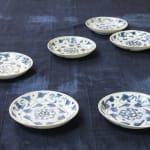






artisan's name unknown
Jingdezhen 景徳鎮 (Keitokuchin) plates (set of 16), early 18th century
ceramic
5: (dia.) x 1 1/2” (h)
Further images
Ceramics were produced in Jingdezhen area in China as far back as the Han dynasty (206 - 220 BC). At the time, the city was called Xinping. The area has...
Ceramics were produced in Jingdezhen area in China as far back as the Han dynasty (206 - 220 BC). At the time, the city was called Xinping. The area has been contributing to the production of ceramics ever since. In 1004, during the reign of Zhengzong, (North Song Dynasty) in the Jing De era, the emperor Zhao Huan ordered the city of Changnan (formerly Xinping) to produce porcelain for the imperial family with the characters “made in Jing De period” on the bottom. Therefore, the city changed its name to Jingdezhen, and its porcelain became prominent throughout the country. In the South Song dynasty(1127 - 1279) the book “Tao Ji” by Jian Qi stated that Jingdezhen porcelain came from 300 distinct kilns. They continued to flourish in the area of porcelain production throughout the history of China. Around the early to mid-1600s, Jingdezhen porcelain showed some signs of decline, but after 1680 it revived and began to make progress. One example of this revival is the blue and white technique originated in the Kangxi period (1661 - 1722), which utilized gem blue, a shade much purer and brighter than before.
Our plates are from this era, during the turn of the 18th century.
We have a saying among porcelain connoisseurs: “don’t own Jingdezhen works until you have first collected enough blue and white works.” Why? Because the blue color of Jingdezhen ware is so pronounced compared to the blue and white ware from other regions, including kilns in Japan. For the untrained eye, this bright color jumps into the eye and blinds, so to speak, its ability to discern the overall harmony and balance of the work.
This set has all the qualities we search for and a rare trait; they can be paired with equally excellent contemporary utensils famously.
There is a tiny crack in the lip of this objects, repaired by the Kintsugi method. This method involves painstakingly filling areas of damage with lacquer and gold. These plates were repaired by the highest level of a master Kintsugi craftsman. They stands as a testament to the owner's care, elevating repair to the level of art.
Our plates are from this era, during the turn of the 18th century.
We have a saying among porcelain connoisseurs: “don’t own Jingdezhen works until you have first collected enough blue and white works.” Why? Because the blue color of Jingdezhen ware is so pronounced compared to the blue and white ware from other regions, including kilns in Japan. For the untrained eye, this bright color jumps into the eye and blinds, so to speak, its ability to discern the overall harmony and balance of the work.
This set has all the qualities we search for and a rare trait; they can be paired with equally excellent contemporary utensils famously.
There is a tiny crack in the lip of this objects, repaired by the Kintsugi method. This method involves painstakingly filling areas of damage with lacquer and gold. These plates were repaired by the highest level of a master Kintsugi craftsman. They stands as a testament to the owner's care, elevating repair to the level of art.
Signup for our Newsletter
You will receive two emails a month from us. One introduces artworks and design works from Kyoto's hidden sources and the other is stories from Misako, sharing insights into Japanese culture.
* denotes required fields
为了回应您的查询,我们将根据我们的隐私政策处理您提供的个人数据。






